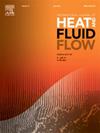Study of flow and heat transfer characteristics and structural optimization of parallel microchannel heat sink
IF 2.6
3区 工程技术
Q2 ENGINEERING, MECHANICAL
International Journal of Heat and Fluid Flow
Pub Date : 2024-11-15
DOI:10.1016/j.ijheatfluidflow.2024.109654
引用次数: 0
Abstract
This study conducted a comprehensive analysis of the flow-boiling heat transfer characteristics and structural optimization for Microchannel Heat Sinks (MCHS). The modified numerical model, based on the extended RPI wall boiling model, was validated against experimental data, showing satisfactory accuracy in predicting heat transfer coefficients and dryout phenomena across a mass flux range of 282 to 1033 kg/(m2s) and heat flux levels up to 116 W/cm2. The research findings indicate that microchannel structure significantly influences vapor phase generation and distribution, and elevated heat flux can lead to a decline in heat transfer performance due to complete evaporation within the channels. The trapezoidal structure of the inlet collection tank induced vortices, which increased flow resistance and decreased flow rate in the initial sections of the channels, causing localized heat accumulation. The use of transverse grooves in the microchannels reduced the flow velocity standard deviation by 70 % and enhanced the average heat transfer coefficient by 30.9 %, effectively alleviating localized high temperatures. While the optimized structure improved overall performance, especially at lower flow rates, a performance decline was observed at higher flow rates. These results contribute to the development of a numerical model applicable to a broader range of flow boiling processes and offer a viable structural optimization strategy designed to enhance thermal management within electronic devices.
平行微通道散热器的流动和传热特性及结构优化研究
本研究对微通道散热器(MCHS)的流动沸腾传热特性和结构优化进行了全面分析。基于扩展 RPI 壁沸腾模型的修正数值模型与实验数据进行了验证,结果表明,在 282 至 1033 kg/(m2s) 的质量通量范围和高达 116 W/cm2 的热通量水平上,预测传热系数和干涸现象的准确性令人满意。研究结果表明,微通道结构对气相的生成和分布有显著影响,热通量升高会导致通道内完全蒸发,从而导致传热性能下降。入口收集槽的梯形结构会诱发涡流,增加流动阻力,降低通道初始段的流速,造成局部热量积聚。在微通道中使用横向凹槽可将流速标准偏差降低 70%,并将平均传热系数提高 30.9%,从而有效缓解局部高温问题。虽然优化后的结构提高了整体性能,尤其是在较低流速下,但在较高流速下性能有所下降。这些结果有助于开发一种适用于更广泛的流动沸腾过程的数值模型,并提供了一种可行的结构优化策略,旨在加强电子设备的热管理。
本文章由计算机程序翻译,如有差异,请以英文原文为准。
求助全文
约1分钟内获得全文
求助全文
来源期刊

International Journal of Heat and Fluid Flow
工程技术-工程:机械
CiteScore
5.00
自引率
7.70%
发文量
131
审稿时长
33 days
期刊介绍:
The International Journal of Heat and Fluid Flow welcomes high-quality original contributions on experimental, computational, and physical aspects of convective heat transfer and fluid dynamics relevant to engineering or the environment, including multiphase and microscale flows.
Papers reporting the application of these disciplines to design and development, with emphasis on new technological fields, are also welcomed. Some of these new fields include microscale electronic and mechanical systems; medical and biological systems; and thermal and flow control in both the internal and external environment.
 求助内容:
求助内容: 应助结果提醒方式:
应助结果提醒方式:


